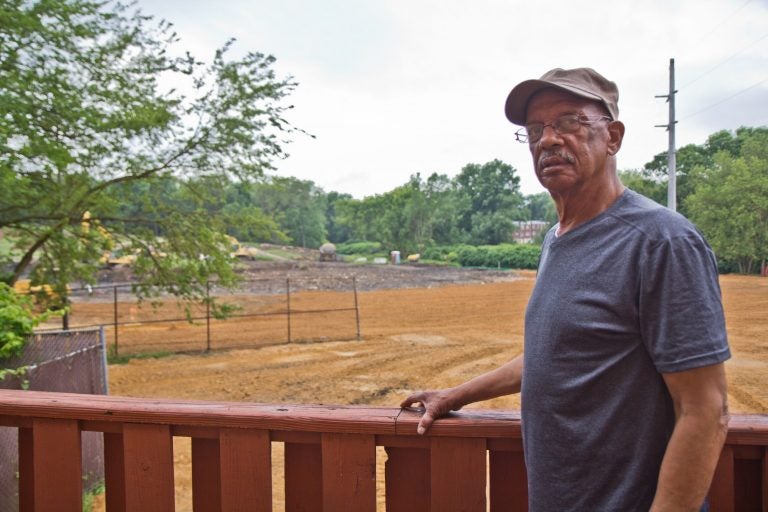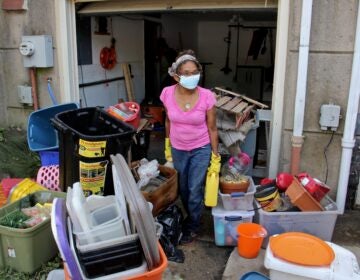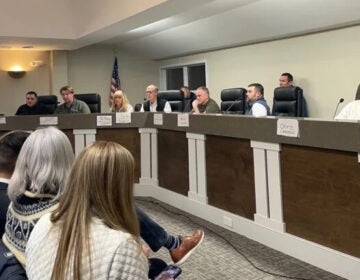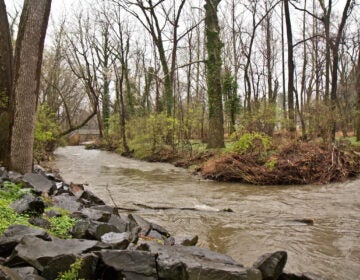EPA: Isaias flooding did not spread toxins from Eastwick landfill
Preliminary results of water samples collected by the EPA from flood waters during and after the storm found “little to no contaminants.”

Leo Brundage, an “old Eastwick” native, returned to the neighborhood in the 1980s. (Kimberly Paynter/ WHYY)
Eastwick resident Leo Brundage has lived next to the former Clearview Landfill, one of the nation’s most contaminated sites, for over 30 years.
For the last three of those years, the U.S. Environmental Protection Agency has been remediating the toxic landfill, after finding pollutants in a city park next to Brundage’s home and in the yards of about 200 residents in the neighborhood.
“Every time we get a storm and get flooded, we will have some bit of contamination in our home,” said Brundage, a 76-year-old resident-turned-activist whose property has flooded more than 10 times since Hurricane Floyd in 1999.
The city built Brundage’s neighborhood in a floodplain, next to a dump, in the 1960s as part of an urban renewal project that was never completed. Last year, Philadelphia and the city Redevelopment Authority agreed to pay $8.4 million to help remediate the toxic dump.
And even though most of the landfill’s waste had been removed and replaced by clean soil when Tropical Storm Isaias hit Eastwick earlier this month, Brundage and his neighbors remained concerned about floodwaters carrying contaminants into their homes.
But according to preliminary results of water samples collected by the agency from flood waters and Cobbs Creek during and after the storm, “little to no site-related contaminants” spread into the neighborhood.
“Looking at the results, and sharing it with our risk assessors and our toxicologists, there’s nothing there that jumps out as like a potential immediate health concern from a short-term exposure when the flooding was happening,” said Josh Barber, the EPA Superfund site project manager for the last 10 years.
Barber said that, based on the analysis, contaminants present in the former dump — substances such as polychlorinated biphenyls (PCBs), polycyclic aromatic hydrocarbons (PAHs) and other toxins such as lead, mercury, pesticides and arsenic — were not detected in the samples, with the exception of lead.
“So the lead was there, but it’s a very low level,” he said.
The EPA will continue to evaluate the samples to publish final results by mid-September, but Barber said unless there’s a significant problem with the results from the lab, the results will be the same.
A second set of samples taken from residents’ yards is currently being analyzed to determine any potential health risks coming from the flood. Barber’s office is also doing more specific risk assessments to determine potential health concerns for people who spent a longer amount of time in the water, waiting to be rescued or cleaning their houses. The concern in those situations is skin contact with the water or incidental ingestion of the water.
Preliminary results from those studies will be made public by the end of September, Barber said.
“I don’t want to jump to conclusions until that part of the evaluation is done, but I did want to share with everybody that the preliminary results were back and the general screening numbers show that from a site standpoint and from a general contaminant presence standpoint, there just wasn’t a lot there on the water,” he said.
According to a fact sheet published on Monday, the flood damaged 10 out of the 200 residents’ yards the EPA had previously remediated. Nine of them have been repaired, while the agency continues to evaluate damage in the neighborhood. But most of the floodwaters, it said, came from the Darby and Cobbs creeks, not the hillside of the landfill.
EPA said the storm did not damage areas of the Superfund site where construction was completed, but it did cause erosion of stabilizing walls built into the banks of the Darby and Cobbs creeks.
“All repairs from storm damage have been completed on the landfill,” EPA said.
Brundage said that he appreciates the work EPA has been doing on the land next to his home, and that the agency has reacted by taking samples and being in close communication with residents.
No contaminants were found in the samples taken from his yard. But he said until the EPA gives everyone the final results, he will still be worried.
“But not as concerned as I was when there was, jeez, contamination all over the place,” Brundage said.

Subscribe to PlanPhilly
WHYY is your source for fact-based, in-depth journalism and information. As a nonprofit organization, we rely on financial support from readers like you. Please give today.








